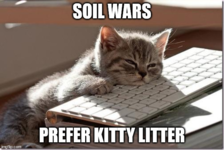I don't believe you addressed the mechanics of how roots of anything grown in the ground in packed soil survive if the theory of bonsai mix is correct that you need a media so porous you could drive a truck through it. We all know that millions of people use millions of different mixes and most of them survive. Many break all the rules, like for instance the Vietnamese that keep their pots wet in a high humidity, high temperature environment. If the rules can be violated, then they're not "rules".
I don't want to hear that you need the best media (yours) to grow trees well. I, and others do differently and grow as well as you. Your turn.
It’s not necessary to discuss root growth for trees in the ground. Bonsai live in pots. And what works best for trees in pots is not the same as what works for trees planted in the ground.
Aldo, remember that the bonsai pot is NOT merely aesthetic. A properly sized bonsai pots helps to construct the growth of the tree, to help keep it small and miniaturized. Yes, a bonsai pit restricts root growth. This aids in keeping leaves small and internodes short. Which helps keep the tree in scale.
Modern bonsai soil, a mix of inorganic particle, typically equal parts of akadama, pumice and lava, have proven over time to provide excellent results for bonsai. There may be instances where the mux ratio can be adjusted, but that is beyond the scope of this discussion.
When a bonsai is freshly repotted, some roots are cut back. The tree will want to replace those roots as quickly as it can, the small “feeder” roots are what absorbs water and nutrients. Large roots, by the way, are eliminated as much as possible. Large roots serve to affix trees to the ground. Bonsai don’t need large roots because the trees are firmly secured to their pots with wire. Large roots in a bonsai pot just take up space that can be better used by smaller feeder roots.
So, when the tree is freshly repotted, the new soil is very open, and it is easy for new roots to grow into the empty voids between particles. Thus, the tree rebuilds it’s root system quickly. It’s not unusual to see large leaves and long internodes on the tree just after a repot. Rapid root growth promotes rapid top growth!
But soon, those new roots will hit the sides of the pot, and fill up the easy inter-particle voids. This is where the akadama comes in. Yes, it’s softer than lava and pumice, and it hold water. The feeder roots will latch on, and start to pressure the akadama, causing it to break down. When a particle breaks, it creates new voids for small feeder roots to fill. But, overall, root growth SLOWS down. Now, the top growth slows. Smaller leaves. Shorter internodes. As the akadama breaks down, it holds more water. Which is a good thing, because the top has more leaves to keep hydrated. You see, the akadama changes it’s structure. In a way that helps the tree survive in an artificially small environment!
After some time, the akadama has broken down too much and/or the tree has produced so many roots it’s become root bound. Then, it’s time to repot, and begin the cycle all over. How often does the tree need repotting? It depends! This is where the bonsai artist observes the health of the tree and makes a determination.
But, remember! Growing trees in little pots IS VERY DIFFERENT FROM growing trees in the ground!
Thus is one of the reasons that Master Gardeners often have poor bonsai. They try to treat their trees as if they were growing in the ground. They’re not.

